
方案详情
文
This article treats of the flow motion over the so-called vortex ripples which
are generated by water oscillations above a sand bed. We focus mainly our experimental
works on the morphology and the dynamics of transient flow patterns above real vortex
ripples. With the help of flow visualizations and Particle Image Velocimetry measurements
with a high-speed video CCD camera, we test numerical simulations, which predict the
existence of a secondary vortex with a streamlines representation. However, our
experimental findings show only one vortical structure and validate the observations of
Bagnold in 1946 (using real ripples but with no visualization and measurement) and Sand
Andersen & al. in 2004 (using model ripples) with respect to the existence of a transient jet.
方案详情

ISFV13-13* International Symposium on Flow VisualizationFLUVISU12 - 12"French Congress on Visualization in Fluid Mechanics GERMAIN ROUSSEAUX July 1-4, 2008,Nice, France FLOW VISUALIZATIONS AND PIV ANALYSIS OVER VORTEX RIPPLES Germain Rousseaux.* *Universite de Nice Sophia-Antipolis CNRS UMR 6621 Laboratoire J.-A. DieudonneParc Valrose 06108 Nice Cedex 2 France KEYWORDS: Main subject(s): sand ripples Fluid: vortex ripples,coherent structures, jet Visualization method(s): PlV measurements Other keywords: flow visualizations ABSTRACT: This article treats of the flow motion over the so-called vortex ripples whichare generated by water oscillations above a sand bed. We focus mainly our experimentalworks on the morphology and the dynamics of transient flow patterns above real vortexripples. With the help of flow visualizations and Particle Image Velocimetry measurementswith a high-speed video CCD camera, we test numerical simulations, which predict theexistence of a secondary vortexx with a streamlines representation.However,,ourexperimental findings show only one vortical structure and validate the observations ofBagnold in 1946 (using real ripples but with no visualization and measurement) and SandAndersen & al. in 2004 (using model ripples) with respect to the existence of a transient jet. 1 Introduction Since the seminal experiments of Brigadier Ralph Alger Bagnold [1], sand ripples and theirassociated fluid flows have become a vivid field of research for physicists as an interesting example offluid-structure interaction. Indeed, the fluid and the granular material interact in a complex way sincethe shape of ripples changes with sand transport which depends on fluid flow. In turn, the lattermodifies the geometry of the patterns. Rolling-grain ripples, the initial state occurring when a flat fluid-granular interface start to deform, are notoriously difficult to observe since their size is of the order of afew millimeters compared to vortex ripples which are the saturated state of the sand bed and whose sizescales with the amplitude of oscillation induced by water waves that is several centimeters [2-9]. Thankstoa particular cylindrical geometry ([4-9]) and particle image velocimetrymeasurements with a high-speed CCD camera coupled to a laser diode, we were able to show theexistence of a transient eddy over rolling-grain ripples which appears at flow reversal and which scaleswith the ripple’s wavelength [7]. Except at flow reversal, no hydrodynamical structure is seen duringthe rest of the oscillation period. This last observation appeared to be contradictory with previoustheoretical works and experimental visualizations since rolling-grain ripples have been characterized so far with couples of recirculating cells corresponding to time-dependent streaming induced by the rippleshape. However, we calculated the time-average over one period of the observed total flow (whichresumes to the time average of the time-dependent streaming) and the resultant steady streaming withthe expected two recirculating cells per trough was observed [7]. In this article, we will focus mainly on the hydrodynamics associated to vortex ripples in orderxoyto contribute to clarify the basic phenomenology of the flow over real vortex ripples. This ends ourintroduction. In part 2, we review the literature and address the relative naive question : How manyvortex characterize a vortex ripple ? Then, the beginning of part 3 introduces the experimental setup aswell as the PIV techniques used to extract the flow field. In section 3.2, we compare our results withthe numerical predictions. Finally, we analyze a vorticity plot before concluding. 2 One or several vortices with or without a transient jet ? The literature about sand ripples is vast and we decided to select some relevant paperspresenting the principal flow configurations that have been introduced so far. Some authors report forthe existence of one or several vortex (vortices) over vortex ripples [1, 2, 4, 10-15]. Moreover,Bagnold [1] and Sand Andersen & al. [13] have shown that another transient structure (as described as"jet") was present in addition to the vortex (vortices). That’s why, to produce quantitativevisualizations and measurements for such a structure over real vortex ripples is essential as noconsensus has emerged until now. We display on Figure 1, as a cartoon, three typical descriptions thatwe encountered in the literature (see below for the definition of the types of structures). Firstly, oneprimary vortex plus a counter-rotating secondary vortex (a). Secondly, one primary vortex plus atransient jet (b). Thirdly, one primary vortex plus a relic vortex (c). There exist several techniques in order to visualize the hydrodynamical structures associated tovortex ripples. Bagnold used silver particles above both real ripples and an artificial ripple model [1].He reported for one or severals vortical structures depending on the flow parameters as well as anotherpattern called by him the "jet": when the flow has just begun to move backward in the reversedirection, a jet of water now begins to squirt down the outward slope ofthe ripple, between the crestand the departing vortex. This jet flicks a volley of grains from the crest downwards parallel with theoutward ripple slope. More recently, Sand Andersen & al. also observed a "jet” using a triangularmodel ripple [13]. In addition, these authors introduced a nice theoretical model of the circulation ofthe vortex taking into account the different forces acting on it. With a wave-tank, Earnshaw & Greated[12] followed the motion of the center of the vortex over a rigid undulated bed but they did not showany visualizations of the structure except a cartoon which features a primary vortex and a "relic”vortexproduced during the last half-period. Scherer & al., using Kalliroscope particles as tracers [4], observeda single vortex with a v-like shape in a cylindrical geometry but their experiments were confined to lowfrequencies over pre-formed real vortex ripples because of the impossibility to visualize the vortex(because of dye mixing) at high frequencies corresponding to the actual frequencies of ripplesformation. The experiments of Ourmières & Chaplin [14] feature two vortices which are created andshed, one during each half of the wave cycle. Once the vortex is ejected, it moves upward and interactwith the one produced earlier (the "relic”vortex) and we can wonder if this "relic”vortex is not at theorigin of the primary vortex shedding. In some cases, these authors reports for a smaller secondaryvortex coupled to the primary vortex shed every half-period (Fig. 11 & 12 in [14]). (c) FIG. 1: Three types of hydrodynamical structures over vortex ripples as described in the literature. The black arrowcorresponds to the background flow direction before reversal. Other vortices were seen by both Hara & Mei [11] and Blondeaux & Vittori [10] in theirnumerical simulations. According to Blondeaux & Vittori (see their Fig. 8 in [10] displayingstreamlines), a secondary vortex ejects the primary vortex so is responsible for the detachment. Yet,Andersen reports for only one vortical structure associated to vortex ripples in its computations [2].Nevertheless, his simulations dealt with turbulent flow and he only calculated mean velocity andvorticity fields. More recently, Eidsvik has described for the first time in a numerical work with aRANS model the role of the jet with respect to the sand flux: As the near bottom flow accelerate to theright, say near wave phase 30, there is a speedup along the upslope ripple side ending in a jet from theripple crest. Below this jet a clockwise recirculating vortex is formed. As the free flow maximum isapproached, near wave phase 90, this vortex becomes large, with a systematic negative near bottomtransport. As the free flow decelerates, near the wave phase 180, the near bottom lead transports thevortex effectively backward and upward. As the free flow changes sign, the clockwise vortexapproaches the ripple crest, forming the new near bottom jet and counterclockwise recirculatingvortex. At about maximum negative free flow,near wave phase 270, the clockwise vortex center isabout a ripple wavelength from where it turned back and about a ripple crest higher. For largeReynolds number flows the turbulent intensity may be very high during the whole wave period andsediments may be entrained over most of the ripple and ejected into the bulk flow by the crest jet,recirculating vortex and intense turbulence [15]. 3.1 Experimental setup and techniques We report here for experiments on flow visualizations and velocity measurements with acylindrical geometry. The setup consists in two concentric cylinders of Plexiglas which are linked onthe top and the bottom by two circular plates. The bottom plate oscillates at a fixed displacementamplitude A and frequency fas it is driven by a brushless motor. The top plate is made of transparentPlexiglas. The mean radius of the cylinders is 135.5 mm and the gap size between the cylinders is 19.0mm. We put a layer of mono-disperse spherical glass beads (diameter d=0.11 mm
确定
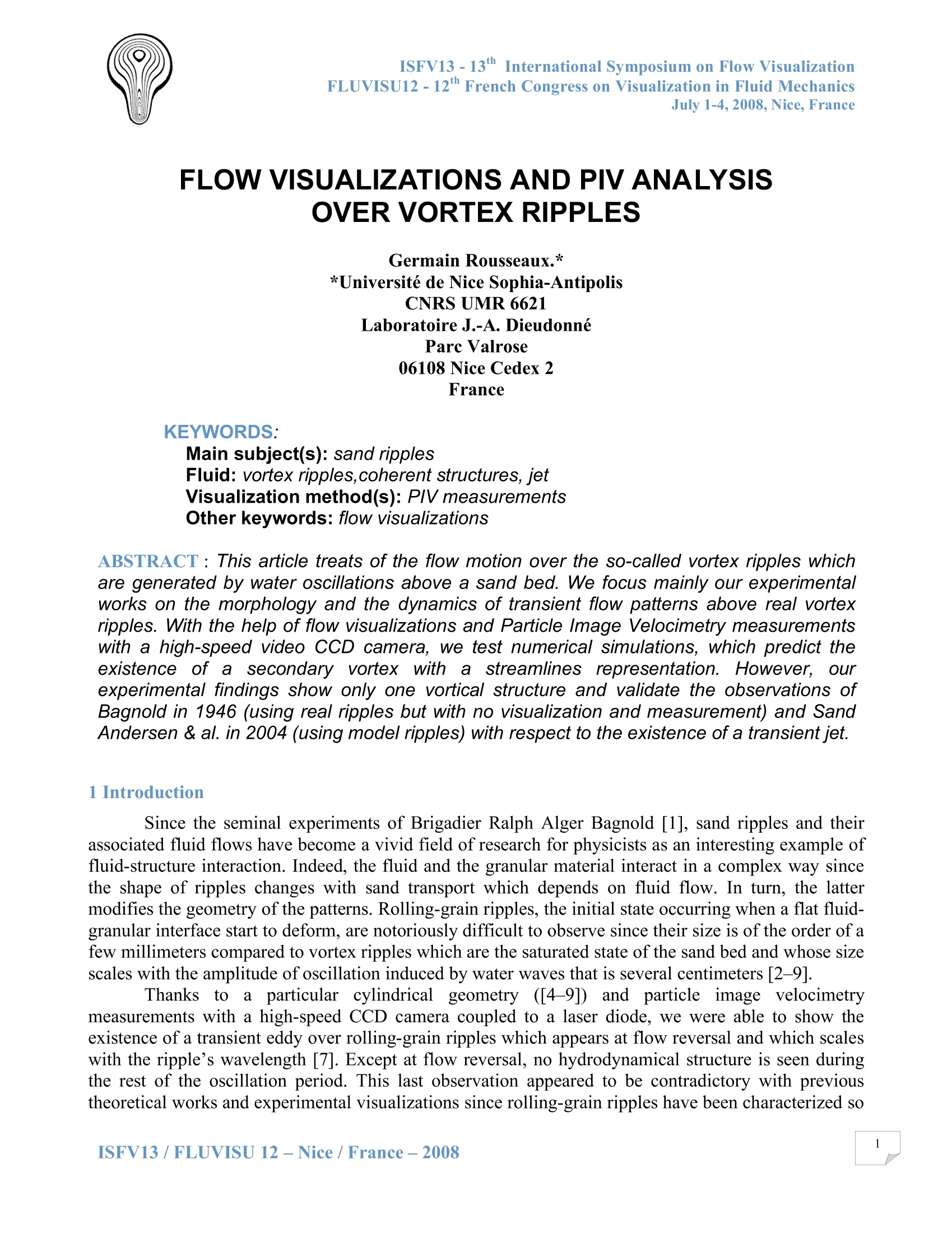
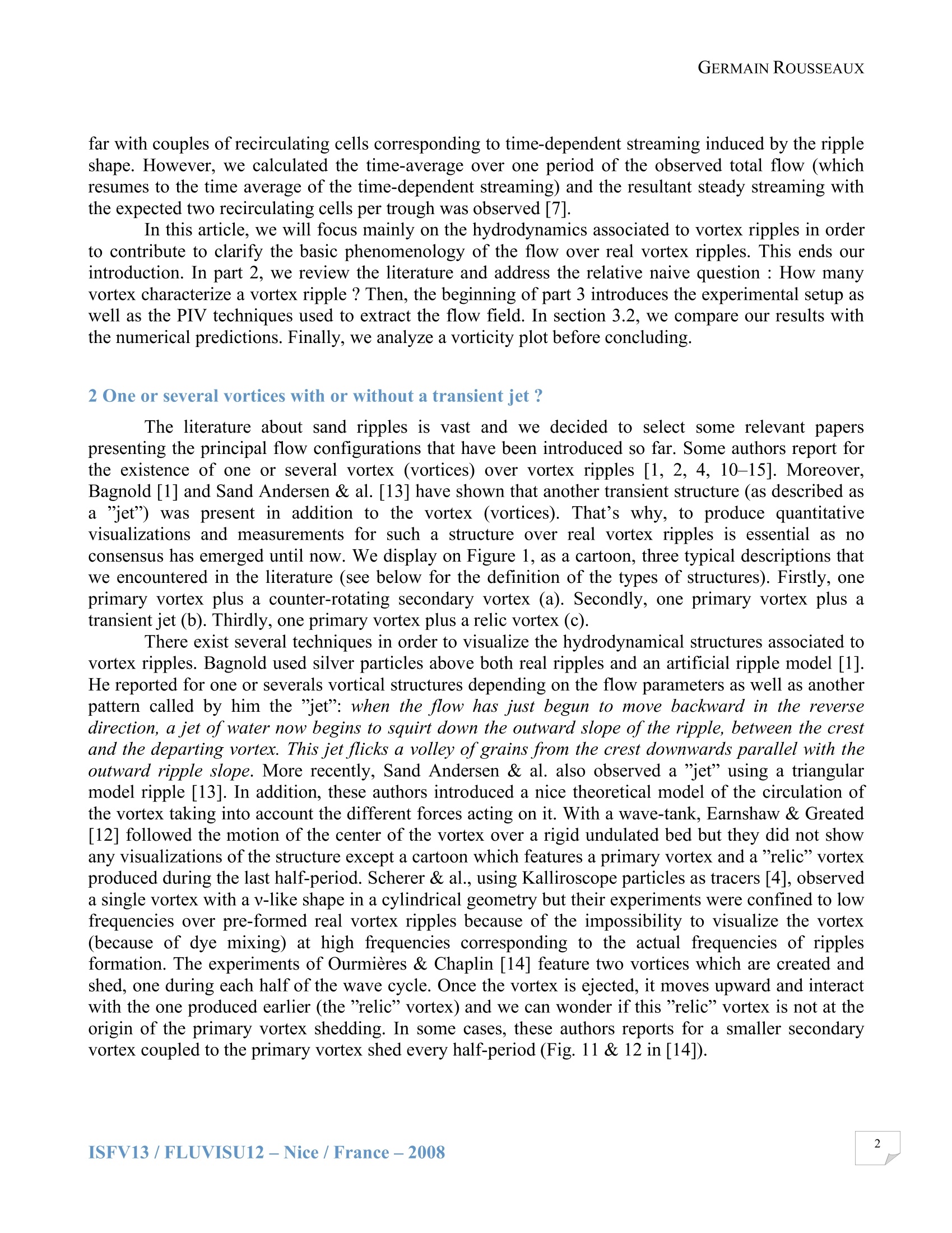
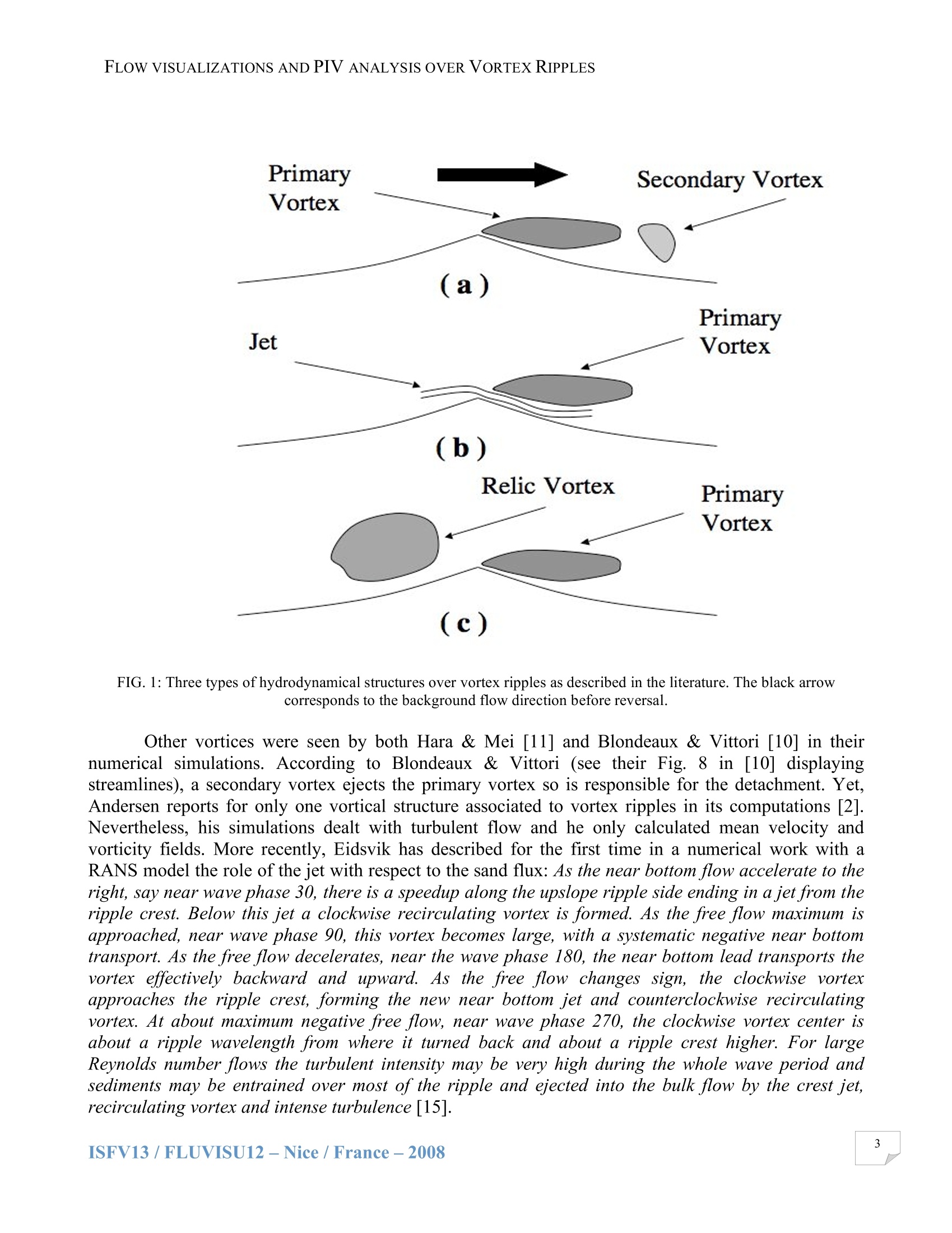
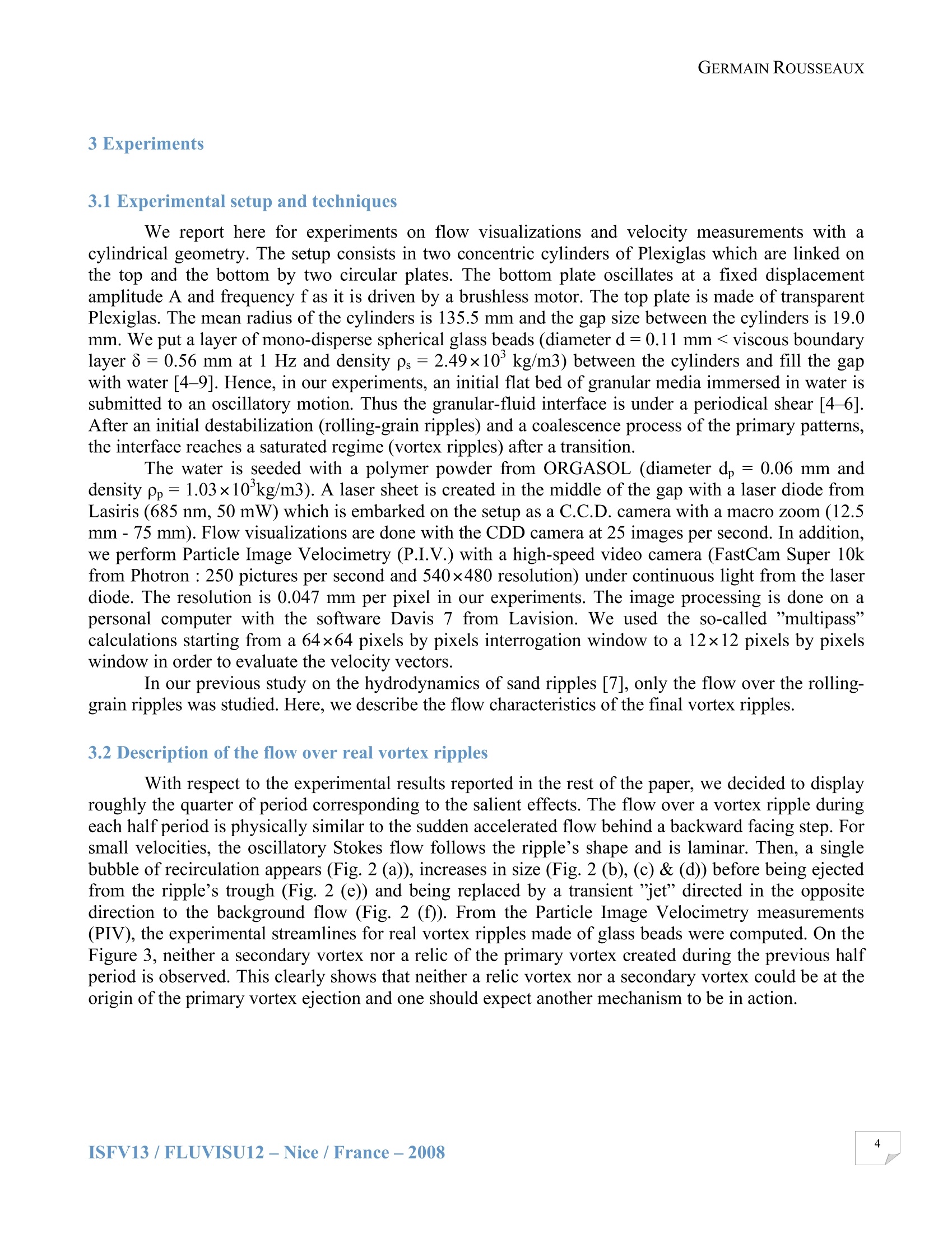
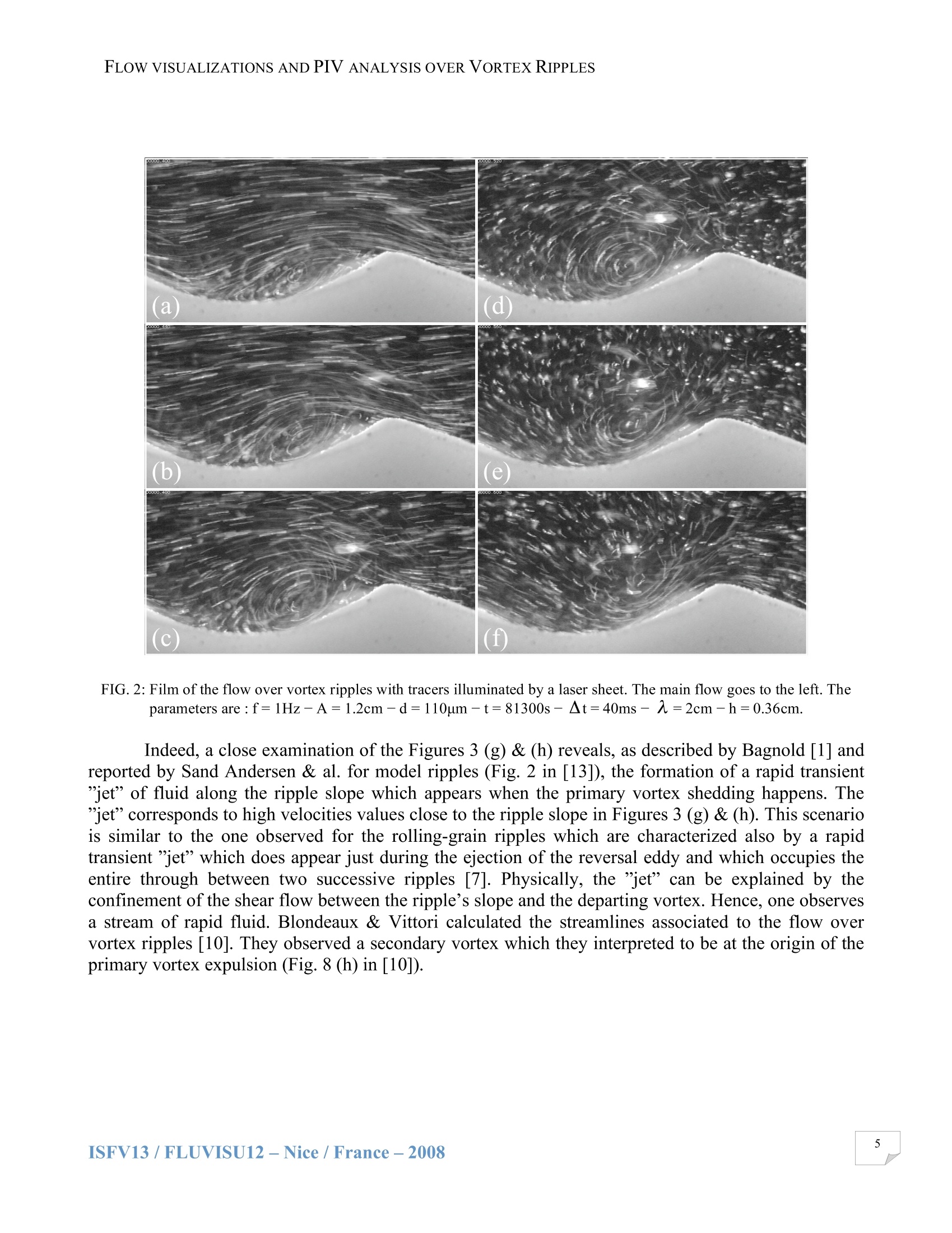
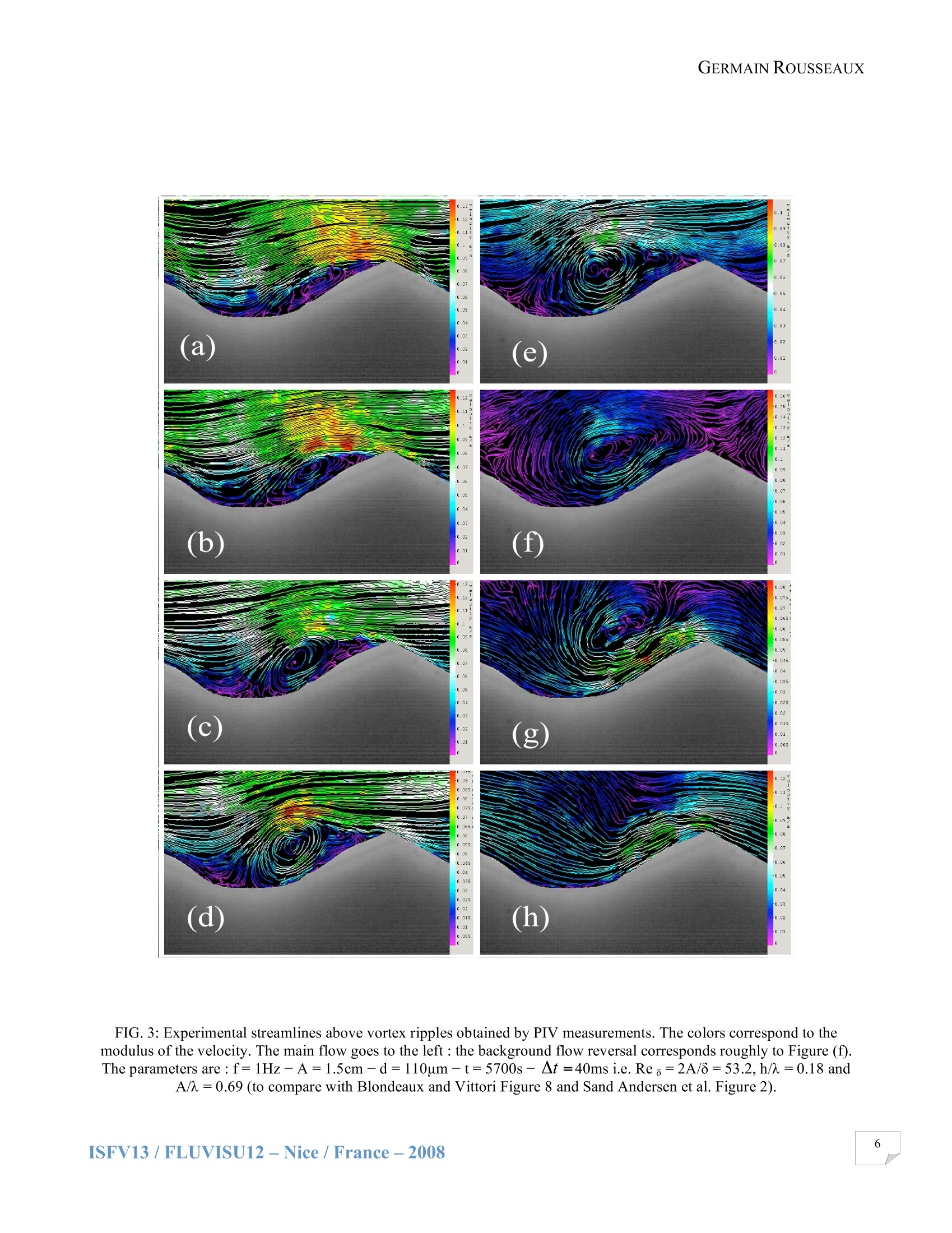
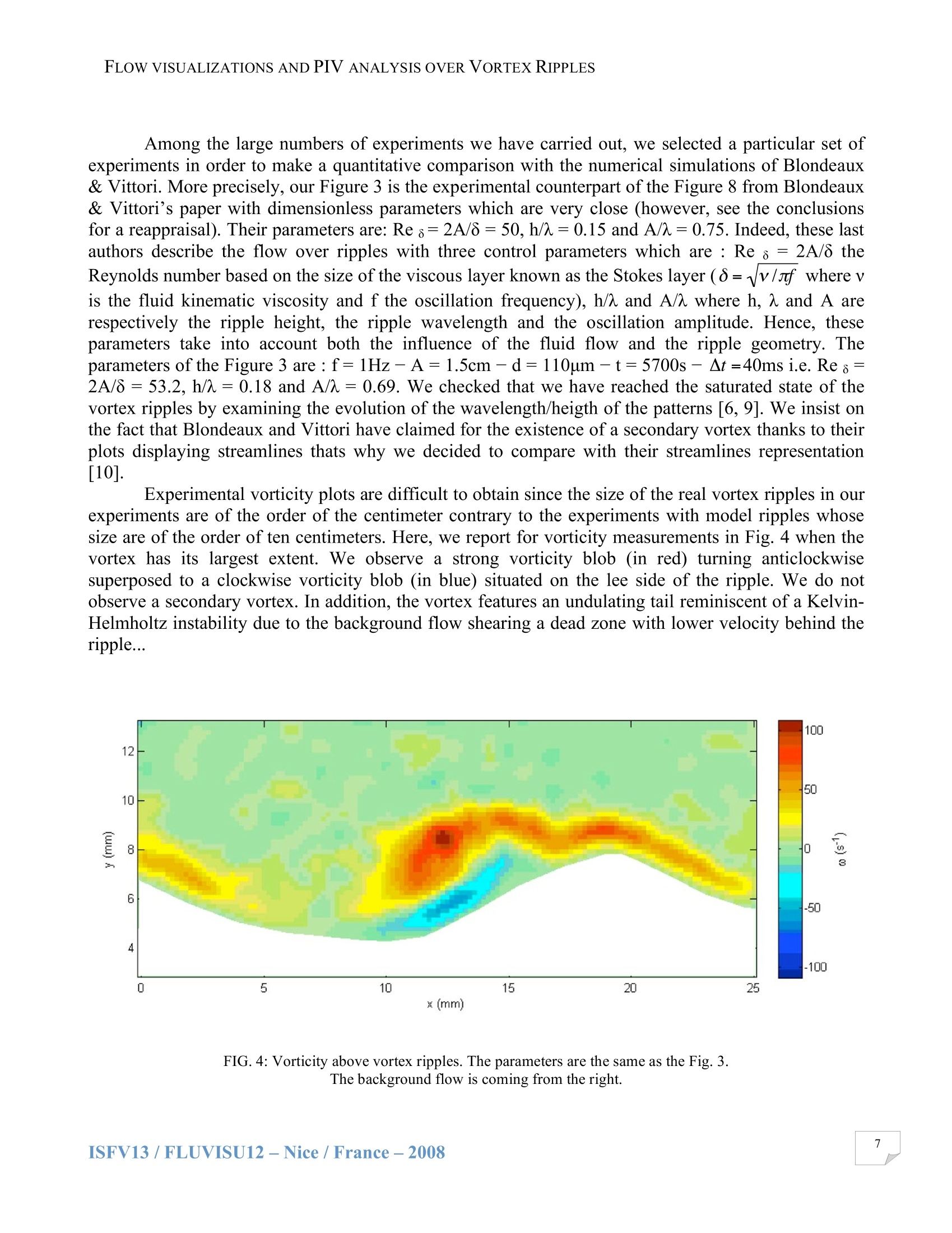
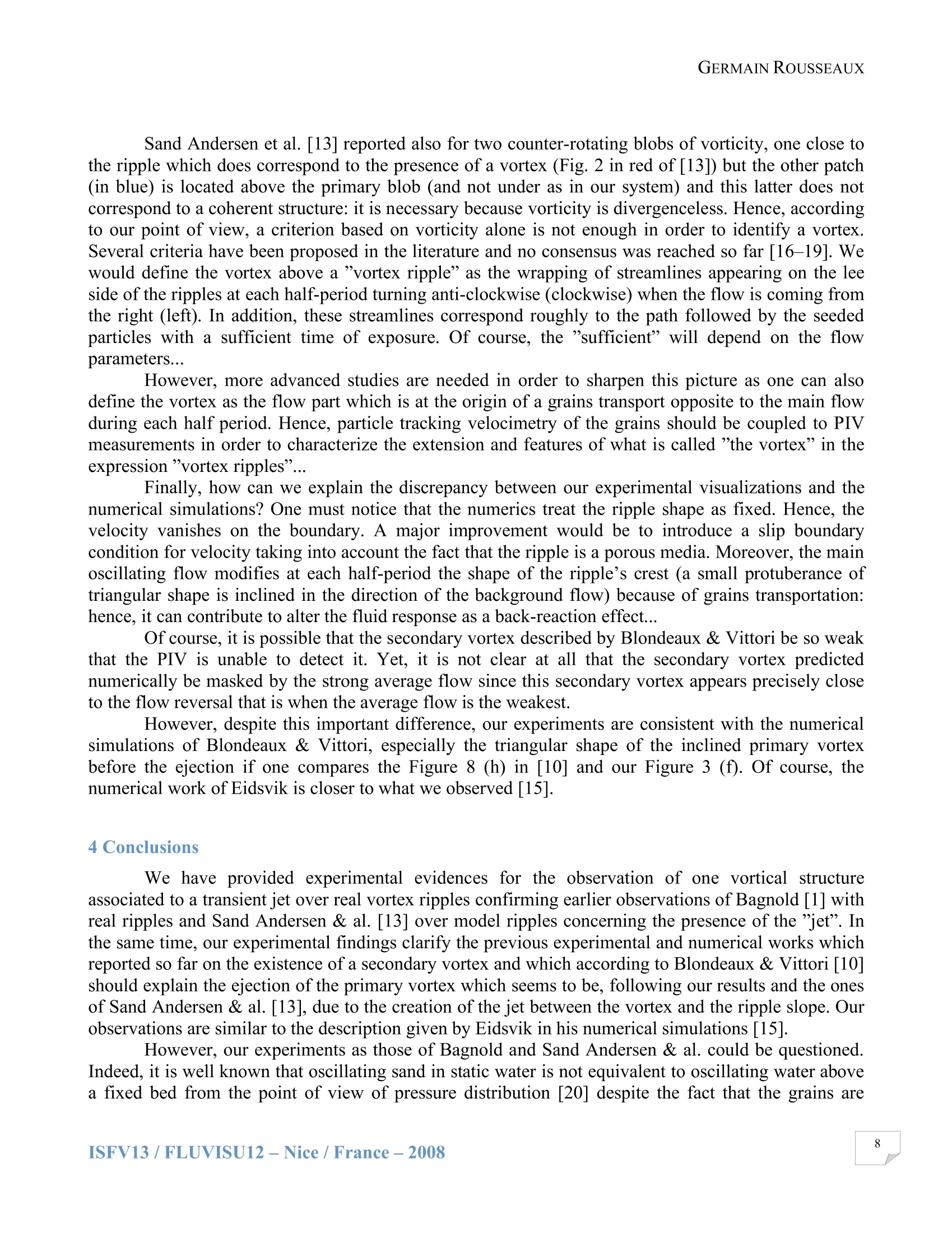
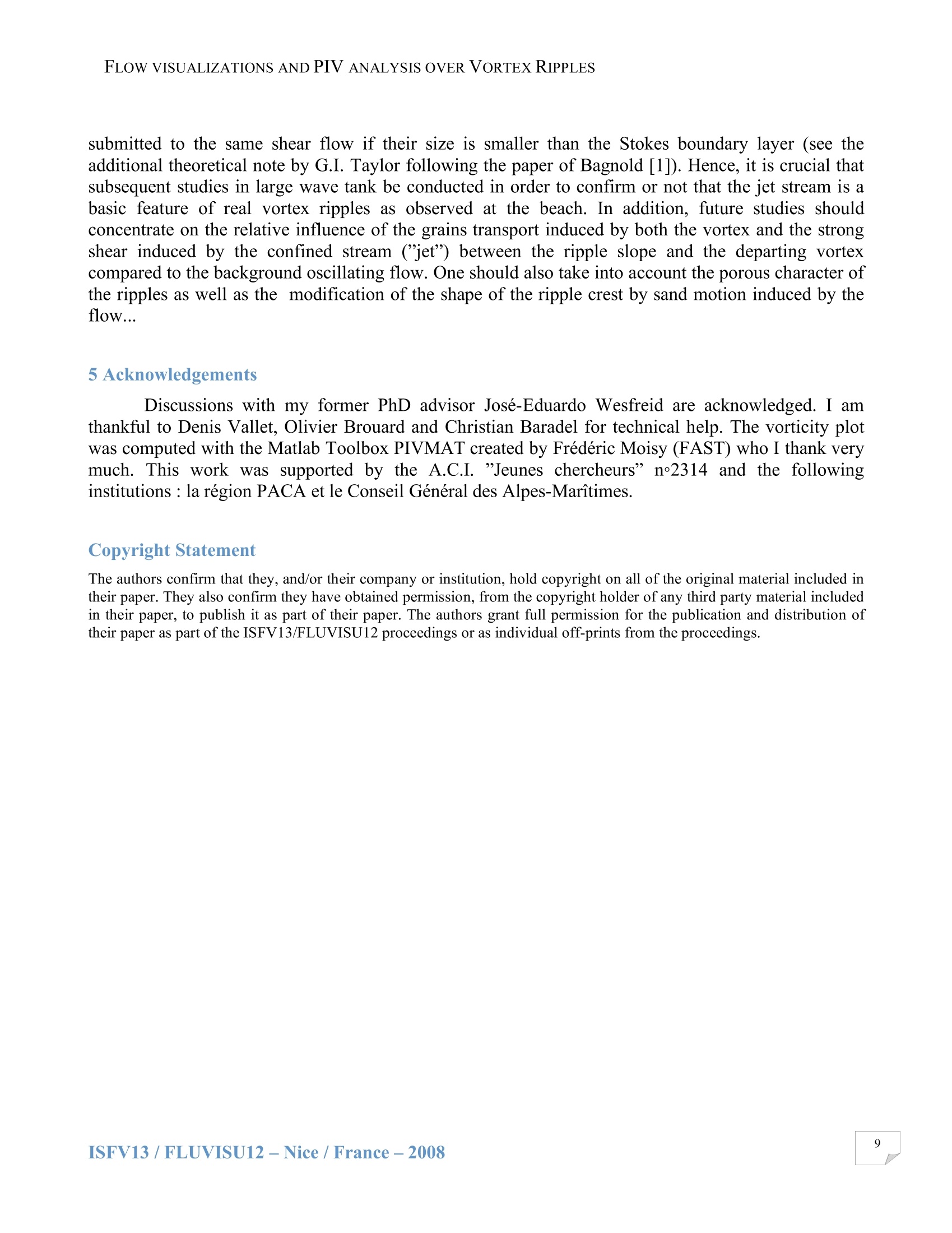
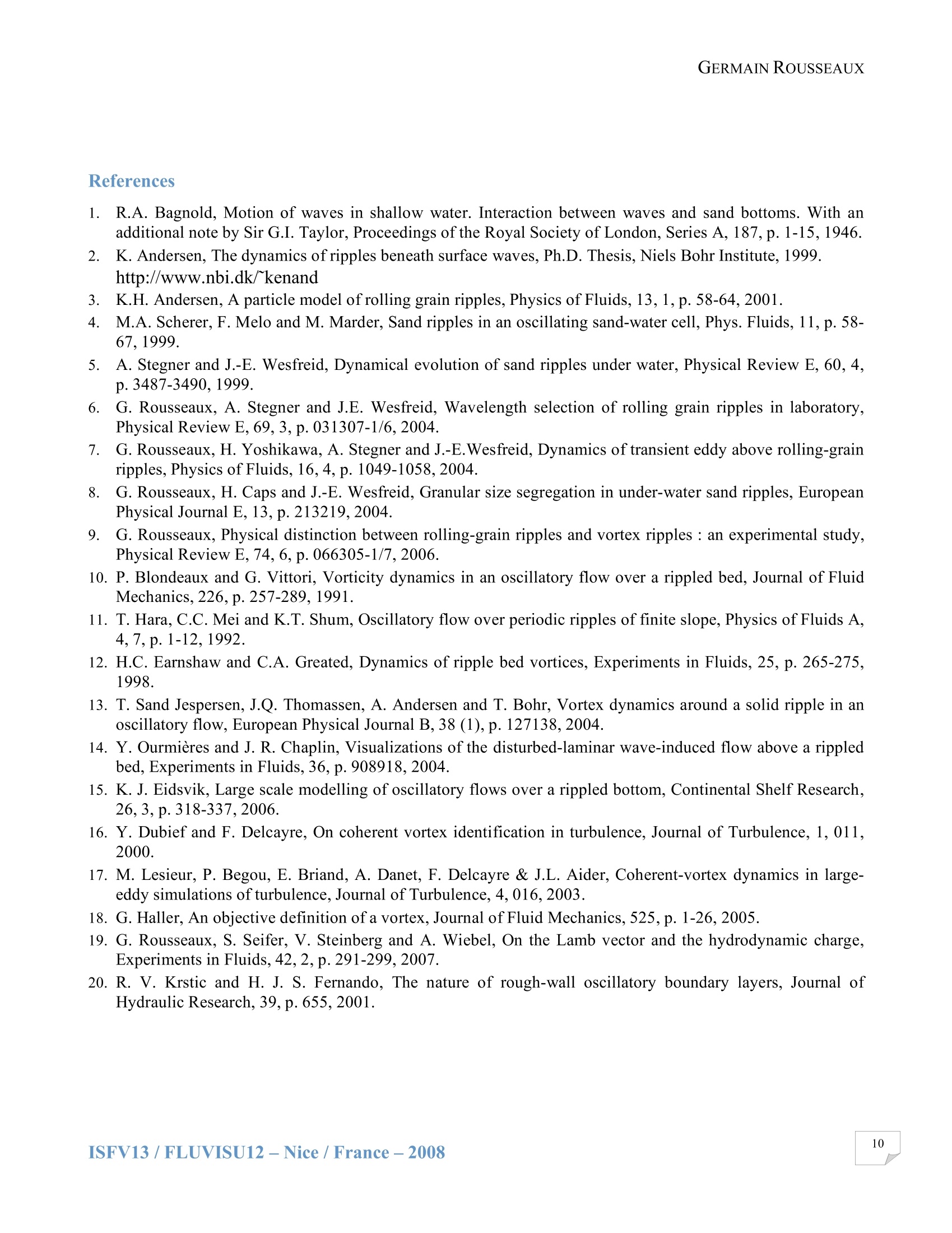
还剩8页未读,是否继续阅读?
北京欧兰科技发展有限公司为您提供《流体中速度场检测方案(粒子图像测速)》,该方案主要用于其他中速度场检测,参考标准--,《流体中速度场检测方案(粒子图像测速)》用到的仪器有德国LaVision PIV/PLIF粒子成像测速场仪、LaVision HighSpeedStar 高帧频相机
推荐专场
相关方案
更多
该厂商其他方案
更多















